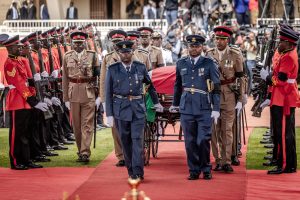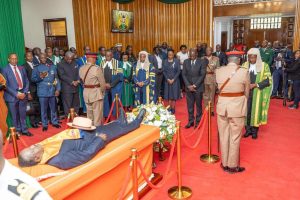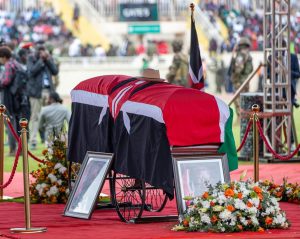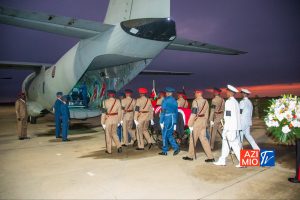News
Raila Enters A Nation’s Coveted Books of State Funerals and Full Military Honors
The symbolism of according Odinga full military honors carries particular weight given his complex relationship with Kenya’s security establishment over the years.
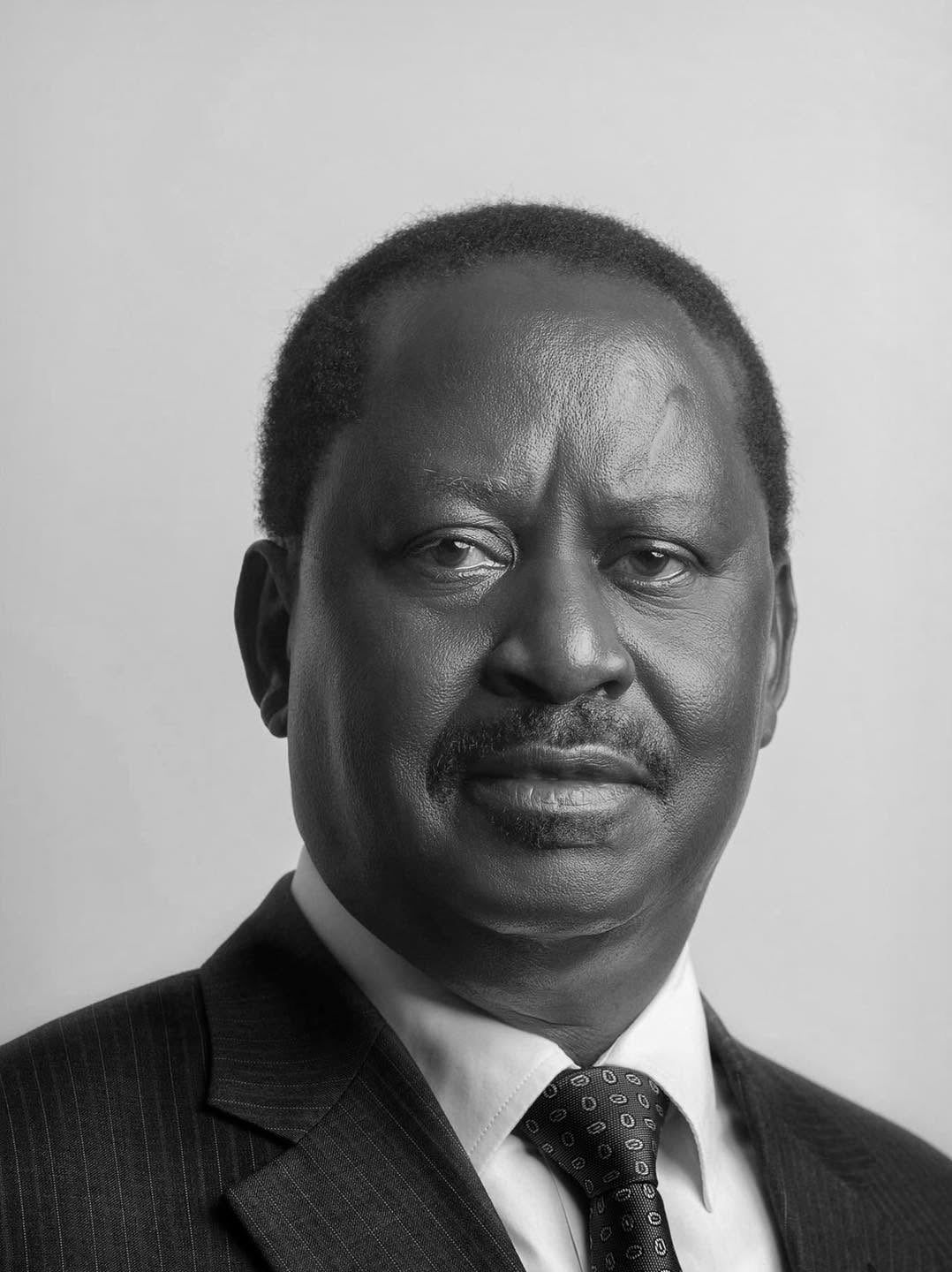
The morning air hung heavy over Nairobi on Friday, October 17, 2025, as the casket bearing the body of Raila Amolo Odinga was lifted onto a gun carriage and began its solemn journey from Lee Funeral Home to Parliament Buildings.
The national flag flew at half-mast across the capital, and thousands lined the streets in silence as the Kenya Defence Forces band played mournful hymns that echoed through the city’s boulevards.
Above, a police helicopter circled Parliament in what seemed a ceremonial tribute to a man who had spent decades addressing crowds from those very grounds, calling for change, justice, and reform.
This was no ordinary funeral. It was a state funeral with full military honors, a distinction reserved for only the most consequential figures in Kenya’s history.
As Odinga’s body lay in state at Parliament Buildings, guarded by uniformed officers standing at attention, the nation paused to acknowledge that one of its most polarizing yet influential political figures had taken his place among an exceedingly select group of Kenyans to receive such recognition.
The procession from Parliament to Nyayo Stadium captured the magnitude of the moment. The gun carriage, draped in the tricolor national flag, moved with deliberate slowness as soldiers marched alongside with military precision.
When the casket arrived at the stadium where thousands had gathered, pallbearers lifted it with ceremonial care as choir harmonies mingled with the rhythmic beat of drums.
The scene was steeped in reverence, a final salute to a man who had, for more than five decades, shaped and reshaped Kenya’s political landscape.
State funerals in Kenya are not commonplace events. They are rare, carefully orchestrated ceremonies that blend Commonwealth traditions with African cultural practices, reserved exclusively for individuals whose lives have indelibly marked the nation’s consciousness.
The practice of lying in state, borrowed from British ceremonial tradition, serves both symbolic and democratic purposes. It allows ordinary citizens to participate in bidding farewell to extraordinary leaders, creating moments of collective mourning that transcend political divides.
The blueprint for Kenya’s state funerals was established in 1978 following the death of founding president Mzee Jomo Kenyatta.
When Kenyatta died suddenly in Mombasa, his body was flown to Nairobi and placed in state at Parliament Buildings in a glass-topped coffin. For ten days, Kenyans from every corner of the young republic filed past, many weeping openly.
The funeral itself was unprecedented in its grandeur. The Kenya Army led a magnificent procession with the casket mounted on a gun carriage pulled by naval officers.
A nineteen-gun salute thundered across the city, followed by the haunting notes of “The Last Post,” the military bugle call signaling the end of duty.
Fighter jets roared overhead in tight formation. It was the first time independent Kenya had witnessed such pageantry, a declaration to the world that a founding father had departed.
For the next quarter century, no other Kenyan would receive comparable honors. The grandeur of Kenyatta’s farewell remained singular until 2003, when Vice President Michael Kijana Wamalwa died just months into his tenure in the NARC government. Wamalwa’s body lay in state at Parliament, marking the first time a vice president received such recognition.
However, his funeral, while solemn and state-funded, lacked the full military honors accorded to Kenyatta. There was no gun carriage, no artillery salute, no aerial display. The distinction was clear: state funerals could be granted, but full military honors remained reserved for an even more exclusive tier.
This pattern continued with subsequent state funerals. When Professor Wangari Maathai, the Nobel laureate and environmental champion, died in 2011, President Mwai Kibaki’s government accorded her a state funeral, the first woman in Kenya’s history to receive such recognition.
Her coffin, crafted from water hyacinth and bamboo in tribute to her environmental legacy, was carried by Kenya Defence Forces pallbearers.
The military presence added ceremonial weight, but there were no gun salutes or fighter jet formations. Instead, her farewell featured songs, poetry, and green tributes celebrating her life’s work protecting Kenya’s forests and championing human rights.
Former First Lady Lucy Kibaki’s state funeral in 2016 followed a similar pattern.
Held in Othaya and officiated by clergy with uniformed officers present, it was dignified yet subdued, lacking the military spectacle that defines the highest level of state recognition.
The landscape changed dramatically in 2020 with the death of Daniel arap Moi, Kenya’s longest-serving president.
At age ninety-five, Moi’s passing marked the end of an era. His coffin lay in state for three days at Parliament as Kenyans queued for hours to pay their respects.
On the morning of his burial, the sound of artillery fire echoed across Nairobi as the Kenya Army delivered a nineteen-gun salute.
His casket was drawn on a gun carriage to Nyayo Stadium, escorted by a full military parade. Fighter jets painted contrails across the sky, and buglers from the Defence Forces played “The Last Post.” Moi had joined Kenyatta in that most exclusive club: presidents who received full military honors at burial.
Two years later, when Mwai Kibaki died in April 2022, the nation once again engaged in the familiar rituals of state mourning.
The government declared three days of national mourning, and Kibaki’s body lay in state at Parliament for public viewing. At Nyayo Stadium, the Kenya Defence Forces executed the ceremony with characteristic precision. A gun carriage bore his flag-draped coffin.
As the national anthem played, a nineteen-gun salute broke the morning silence, each volley symbolizing the nation’s final respect to a leader remembered for economic reform and quiet integrity. Kibaki became the third president to receive full military honors, cementing the tradition that Kenya’s heads of state would be honored with the highest ceremonial protocols.
Between these presidential funerals, other notable Kenyans received state recognition without full military honors. In 2023, Mukami Kimathi, widow of Mau Mau freedom fighter Dedan Kimathi, was accorded a state funeral in Nyandarua County.
Though not granted a gun salute, military officers formed part of her procession in a ceremony both historical and symbolic, representing the nation finally paying its debt to the freedom generation.
The following year brought an unusual state funeral for marathon world record holder Kelvin Kiptum, who died in a car crash at just twenty-four. His coffin was draped in the national flag in recognition of the pride he brought Kenya through his record-breaking achievements.
It was a rare honor for a sportsman, demonstrating that state funerals could extend beyond politicians to encompass national heroes from other spheres.
Then, in April 2024, came the devastating death of General Francis Omondi Ogolla, Chief of Defence Forces, in a helicopter crash alongside nine officers. His send-off in Siaya combined the highest state and military traditions.
A gun carriage bore his flag-draped coffin, and a nineteen-gun salute thundered through the hills as military jets soared overhead.
It was perhaps the most complete display of military ceremony Kenya had witnessed since independence, honoring not just a general but the very institution of the armed forces.
The Defence Forces follow strict protocols regarding military honors.
According to their Standing Orders, full military honors typically include a flag-draped casket signifying state burial, military pallbearers, a gun salute, and the playing of “The Last Post.” Those entitled to state burials include serving and retired presidents, serving and retired prime ministers who act as head of state or government, serving and retired vice or deputy presidents, and general officers up to the rank of brigadier.
The orders further stipulate graduated honors: serving presidents receive a twenty-one-gun salute, retired presidents and sitting prime ministers receive nineteen guns, while retired prime ministers are honored with seventeen guns.
With Raila Odinga’s funeral, Kenya adds a tenth name to its list of state funerals and a fifth to the even more exclusive roster of those accorded full military honors.
As a former prime minister who served in Kenya’s unique power-sharing government from 2008 to 2013, Odinga occupied a constitutional role that entitled him to the highest ceremonial recognition. Yet his inclusion in this pantheon extends beyond constitutional entitlement.
Odinga’s political career spanned more than five decades, during which he emerged as one of Kenya’s most consequential figures, shaping the nation’s democratic trajectory through liberation struggles, election battles, constitutional reforms, and ultimately coalition governance.
The symbolism of according Odinga full military honors carries particular weight given his complex relationship with Kenya’s security establishment over the years.
From his detention without trial in the 1980s to his role as prime minister commanding state resources, his journey traced Kenya’s own evolution from authoritarian rule to multiparty democracy
The military precision with which his funeral was conducted, the gun carriage bearing his remains, the nineteen-gun salute echoing across Nairobi, represented not just protocol but reconciliation, a nation acknowledging that even its most contentious political figures deserve honor when their service to the republic is undeniable.
As Odinga’s coffin rested under tight military guard ahead of his final journey to Bondo, the bugler’s notes still hung in the air, marking both an ending and a beginning.
The closing of one era and the quiet assurance that in Kenya, some legacies transcend the political battles that defined them. State funerals with full military honors remain rare precisely because they are meant to unite the nation beyond partisan divisions. They are moments when flags, anthems, and uniforms merge into collective acts of remembrance.
From the solemn march at Kenyatta’s funeral to the thundering salutes at Raila Odinga’s send-off, each ceremony has reminded Kenyans that their nation still knows how to honor service, sacrifice, and leadership. The military presence at these funerals, with its discipline, order, and solemnity, offers a visual metaphor for continuity, suggesting that even as individual leaders pass, the institutions they served endure.
Kenya’s ten state funerals spanning nearly five decades tell the story of a nation grappling with how to honor its most significant figures.
They reveal a country that has developed its own ceremonial traditions, blending inherited Commonwealth protocols with indigenous practices to create uniquely Kenyan moments of national mourning.
The distinction between state funerals with and without full military honors reflects careful calibration of recognition, ensuring that the highest ceremonial protocols remain reserved for those whose roles and contributions merit the nation’s most solemn tribute.
Raila Odinga now joins Jomo Kenyatta, Daniel arap Moi, Mwai Kibaki, and Francis Ogolla in that most exclusive circle. His entry into this coveted book represents more than ceremonial protocol.
It marks official recognition that however divisive his politics may have been during his lifetime, his contribution to Kenya’s democratic journey earned him a place among those the nation chooses to immortalize not through power, but through the way it says goodbye.
As the final preparations continue for his burial in Bondo, the message resonates clearly: in Kenya’s evolving democracy, even the fiercest opposition leader can ultimately be embraced by the state, honored with its highest military traditions, and remembered as someone who, despite everything, served the republic.
That transformation from political combatant to honored statesman, formalized through the ancient rituals of military pageantry, may be the most powerful legacy of Kenya’s state funerals with full military honors.
Kenya Insights allows guest blogging, if you want to be published on Kenya’s most authoritative and accurate blog, have an expose, news TIPS, story angles, human interest stories, drop us an email on [email protected] or via Telegram
-
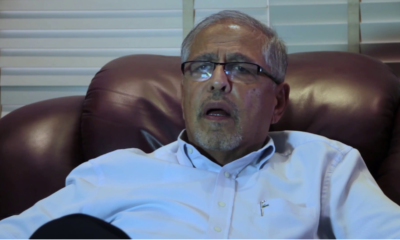
 News4 days ago
News4 days agoTemporary Reprieve As Mohamed Jaffer Wins Mombasa Land Compensation Despite Losing LPG Monopoly and Bitter Fallout With Johos
-

 Business2 weeks ago
Business2 weeks agoPanic As Payless Africa Freezes With Billions of Customers Cash After Costly Jambopay Blunder
-
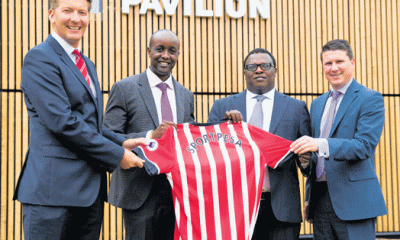
 Investigations1 week ago
Investigations1 week agoHow SportPesa Outfoxed Paul Ndung’u Of His Stakes With A Wrong Address Letter
-
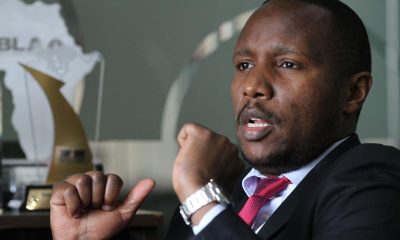
 Investigations4 days ago
Investigations4 days agoFrom Daily Bribes to Billions Frozen: The Jambopay Empire Crumbles as CEO Danson Muchemi’s Scandal-Plagued Past Catches Up
-

 News2 weeks ago
News2 weeks agoSCANDAL: Cocoa Luxury Resort Manager Returns to Post After Alleged Sh28 Million Bribe Clears Sexual Harassment and Racism Claims
-

 Sports3 days ago
Sports3 days ago1Win Games 2025: Ultimate Overview of Popular Casino, Sports & Live Games
-

 Investigations1 week ago
Investigations1 week agoInside the Deadly CBD Chase That Left Two Suspects Down After Targeting Equity Bank Customer Amid Insider Leak Fears
-

 Business4 days ago
Business4 days agoHass Petroleum Empire Faces Collapse as Court Greenlights KSh 1.2 Billion Property Auction

